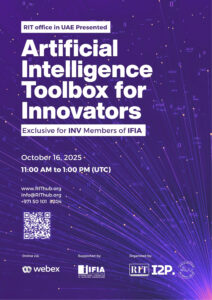

- This event has passed.
Artificial Intelligence Toolbox for Innovators
October 16 @ 11:00 - 13:00
What is an invention?
An invention is the creation of a new solution that did not previously exist—whether in structure, method, or application. It represents a core part of the innovation process: a journey that begins with an idea and culminates in a usable product, service, or technology. Many inventions fail when they do not utilize analytical and enabling tools such as artificial intelligence. The absence of data analysis, simulation, and predictive modeling often leads to incomplete development or high-risk outcomes.
In contrast, integrating AI into the invention process can accelerate ideation, enhance design, uncover flaws, and even generate unexpected insights. However, important questions arise: Who owns an invention created with the help of AI? Is it the human, the model, or the organization? According to global reports from WIPO and the OECD, the use of AI tools in research and development over the past five years has increased the rate of innovation by approximately 35% and the speed of commercialization by 27%.
In this module, participants will explore the deep connection between artificial intelligence, creative thinking, and the process of invention and learn how to harness it in their own innovation journeys.
1. Go Beyond “Prompt Writing” — Move Toward the Philosophy of the Prompt
- Understanding the human mind in interaction with the machine
- How LLMs reflect your personality
- Introduction to Reinforcement Learning from Human Feedback (RLHF)
- The impact of persona in shaping creative responses
- How tone, logic, and emotion influence the model’s output
- Prompt DNA: building the gene of creativity in conversations with AI
2. The Boundary Between Science and Intuition
- Turning raw data into innovative insights
- Creating ideas beyond logical limits with LLMs
- Modeling intuition within the invention process
3. Build Contrast (Contrast-Based Learning)
- Is artificial intelligence truly creative — or not?
- A good prompt isn’t always clear; sometimes it must remain ambiguous
- Can models be more innovative than humans, or are they simply reflections of us?
4. Apply Concept Fusion
- Combining unrelated fields to generate new ideas
- AI + Philosophy of Mind
- AI + Industrial Design
- AI + Storytelling
5. Create Experience (Not Just Teaching, But Experiencing)
- Writing a prompt that generates better prompts itself
- Asking AI to creatively deconstruct the weaknesses of an invention
- Simulating different roles such as a critical investor, a customer, or one’s own future self




